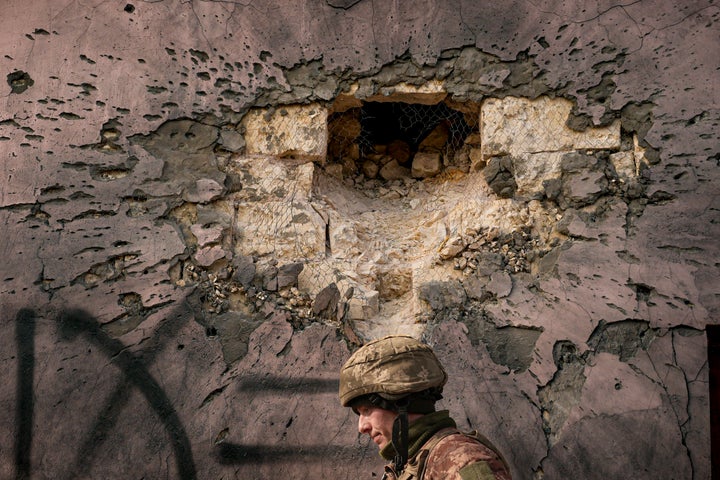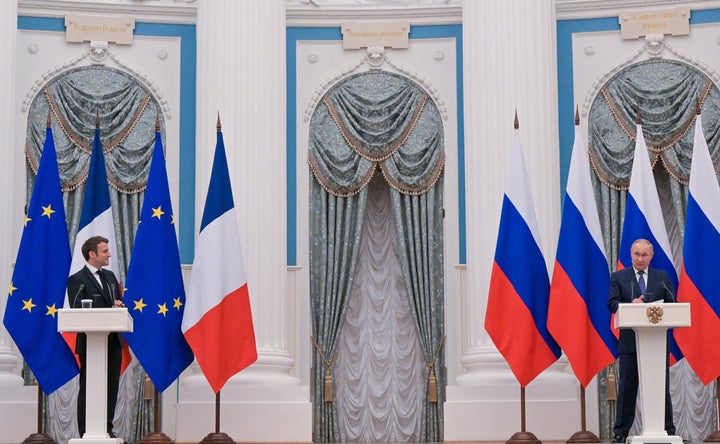Russian troops have begun invading neighboring Ukraine, a White House official said Tuesday, defying fierce diplomatic efforts by world leaders and President Joe Biden’s threats of severe economic retaliation.
A White House national security adviser, Jonathan Finer, told CNN that “the beginning” of Russia’s “latest invasion” was underway and that Biden would be rolling out new sanctions against Russia “in a matter of hours.”
Russian President Vladimir Putin said Monday that he sees parts of eastern Ukraine that are controlled by separatist militias as independent countries and wants to redraw European borders for the first time in decades ― a violation of international law.
The Kremlin previously published decrees ordering Russia’s defense ministry to deploy what it called “peacekeeping” forces in Ukraine’s Donetsk and Luhansk regions, the two Russia-backed separatist territories. At the time, it wasn’t immediately clear whether or when Russian troops would enter Ukraine and choose to fight the Western-backed Ukrainian military.
The invasion comes after an increasingly tense crisis between Russia and Ukraine, which has been trying to escape Russia’s grip by moving closer toward becoming a democracy and aligning itself with the West. Russia has been building up its military along its 1,200-mile border with Ukraine since 2014, but recently accelerated its moves to try and force the U.S. and its allies to promise to keep the smaller nation out of the NATO military alliance.

Russia’s buildup of more than 150,000 troops along the Ukrainian border allows for the international superpower to launch a combined-arms assault from multiple directions if it chooses to do so. Putin’s support of the Donetsk- and Luhansk-based separatists ― which he first revealed to his French and German counterparts ― threw away a yearslong diplomatic effort by the two countries to end fighting between Ukraine and the Russian-backed separatists.
The Biden administration and its allied countries have warned that a massive war could break out should Russia invade the Ukrainian regions, causing widespread instability and violence in Europe.
The White House has repeatedly said that U.S. troops will not fight Russians on behalf of Ukraine, but has sent thousands of American soldiers to European ally countries that have their own safety concerns related to Russia’s actions. The U.S. has also sent Ukraine military aid, and has promised to impose severe sanctions on Russia in response to further action.
In response to Putin’s announcement recognizing two eastern Ukrainian regions as independent countries, the White House said that Biden would issue an executive order banning new investment, trade and financing by Americans “to, from, or in the so-called DNR and LNR regions of Ukraine.”
“This E.O. will also provide authority to impose sanctions on any person determined to operate in those areas of Ukraine,” White House press secretary Jen Psaki said on Monday. “To be clear: these measures are separate from and would be in addition to the swift and severe economic measures we have been preparing in coordination with Allies and partners should Russia further invade Ukraine.”
Germany on Tuesday said it would pause a pipeline that would have dramatically increased its imports of Russian gas. The U.S. and the United Kingdom have also been arming Ukraine, as have the Baltic states.

Biden, French President Emmanuel Macron and German Chancellor Olaf Scholz had been working to negotiate with Putin to de-escalate the border crisis, suggesting they do not see Ukraine as a potential NATO member and offering to recognize Russia’s stature and interests.
“We believe President Putin has made the decision, but until the tanks are actually rolling, and the planes are flying, we will use every opportunity and every minute we have to see if diplomacy can still dissuade President Putin from carrying this forward,” U.S. Secretary of State Antony Blinken said Sunday on CNN.
Those efforts appear to have failed.
In mid-February, Putin claimed that Russia had begun a partial pullback in its military presence near the Ukraine border. However, U.S. officials denied that claim and instead accused Russia of increasing the number of troops at the border by 7,000.
Ahead of the invasion, Ukrainian President Volodymyr Zelenskyy asked to meet with Putin in hopes of reaching a “peaceful settlement.”
To try to help prevent escalation into an attack on Ukraine, Biden held a virtual summit with Putin on Dec. 7. Then, from Jan. 10 to Jan. 12, three discussions took place: one between the U.S. and Russia, one between NATO countries and Russia, and one among members of the Organization for Security and Cooperation in Europe (OSCE). None ended with a solution.
On Jan. 21, Blinken tried to renew the efforts by meeting with Russian Foreign Minister Sergey Lavrov in Geneva, Switzerland. That meeting also resulted in an impasse.
During talks, Russia gave a series of demands in order to agree to a more peaceful approach. Some of the demands are automatically off the table with U.S. and NATO allies, such as Moscow wanting guarantees NATO would not expand eastward, including to Ukraine, and a rolling back of military deployment to some former Soviet states.
The demands are “a Russian attempt, not only to secure [Putin’s] interest in Ukraine, but essentially re-litigate the security architecture of Europe,” Michael Kofman, the Russia studies research director at analysis organization CNACNA, told Vox.
NATO allies released a statement during the 2008 summit in Bucharest saying they look forward to eventually welcoming Ukraine and Georgia as members. This heightened concerns for Russia, which already opposed the alliance’s decision to admit 14 new members after the 1991 collapse of the Soviet Union.
While the alliance is currently divided on admitting Ukraine and Georgia, it still insists on keeping its door open to new members. Nations can join only if all existing members agree to allow them in. Because NATO is considered a defensive military alliance, Russia views Ukraine joining the alliance as a security issue, considering the vast border it shares with the country.
